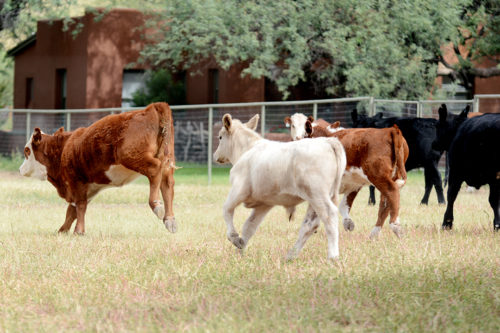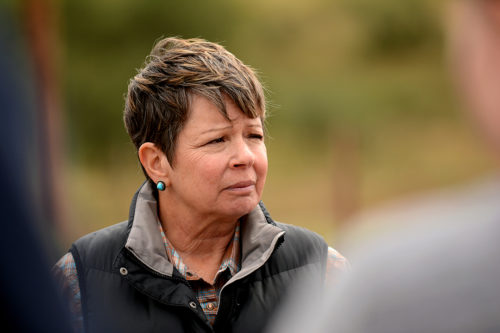
By SYDNEY RICHARDSON
Arizona Sonora News
A cowboy, at least as the stereotype suggests, is a young, muscular man, riding a horse into the sunset. But at the Santa Lucia Ranch, 55 miles south of Tucson and 40 miles from the U.S-Mexico border, the cowboys are all above 60 years old out on the range doing the day-to-day dirty work to produce a yearly crop of cattle and make a living.
The secret for cattle ranching is timing, and after forty years of full-time cattle-ranching Jon and Peggy Rowley, owners of the Santa Lucia Ranch, have their timing down.
If the Rowleys had four hundred cows at the end of a year, the goal would be to have all those cows produce a calf at exactly the same time. In a perfect world all these calves would be born in January, and the Rowleys then have a crop or a “package for sale.” That package is best sold if the crop has reached 500 pounds by October and is ready for the yearly round up.
“That’s when their mothers don’t want them anymore and the customers do,” Jon said.
Even though January and October are the months where the most excitement happens with the birth of a crop and then later the roundups, it’s the months in-between that are the most crucial — and when the most problems can arise.
During those months, the calves are branded and castrated in accordance with Arizona and Pima County codes in order to sell meat. And from there the cowboys work to bulk up the cows through grazing.
Cowboys move cows from spot to spot to allow the herd to graze upon the growing grass and gain a couple hundred pounds along the way. Once one area’s grasses have been grazed down, the cowboys then round up the calves and move them to another spot.
According to a 2014 study by the University of Arizona’s Cooperative Extension Department of Agricultural and Resource Economics “The Contribution of the Beef Industry to the Arizona Economy,” grazing is the dominant land use in Arizona. 98 percent of Arizona’s agricultural land is used for grazing and 73 percent of Arizona’s total land. Needless to say, grazing is not only a big deal to the cows but to Arizona as well.
One of the most prominent problems of cattle ranching across the country is drought. Water is necessary in order for there to be vegetation across the land for the cows to graze and bulk up upon, and for the cows in Southern Arizona it’s either feast or famine.
While the spring months are the perfect time for rain and growth in popular ranching areas like Wyoming, the dry spring months in the desert create roadblocks in the growth of the crop.

“Drought isn’t the exception, it’s the rule,” according to the New Ranch Handbook: A Guide to Restoring Western Rangelands.
According to a Defenders of Wildlife report “Climate Change and the Sonoran Desert Region,” much of the Sonoran Desert has seen anywhere between a 25 to 40 percent drop in precipitation over the past 50 years.
Fortunately for the ranchers of Southern Arizona rain has been favorable in recent years resulting in abundant grass and feed for the cows.
Water resources aside, the U.S-Mexico border regions have one condition that’s unique to ranches in southern California, Arizona, New Mexico and Texas: The movement of undocumented migrants crossing the border.
“We’ve got all this illegal activity happening,” says Dan Bell, former president of the Arizona Cattle Growers’ Association and rancher whose range touches the border. “You’re trying to maintain a working and productive ranch with all this outside stuff happening.”
While oftentimes migrants from Mexico will keep to themselves, they don’t realize the effect they have on the range they are walking across.
Bell recalled times where immigrants coming into the U.S. have left trash for the calves to get into. There was one particular instance that they had left tuna cans on the range, and calves had found them, stepped on them and gotten their hooves stuck. If the cans went unnoticed by any of the cowboys the calves’ circulation could have been cut off from the hooves resulting in death, Bell said.
Meanwhile, back at the Rowley ranch, ten months have passed since the birth of the crop, much of the land has been grazed and the crop had bulked up significantly, it’s now time for the harvest.
For the annual harvest, the three cowboys, the oldest of whom just retired at 88 and the youngest is 66, go out on horseback to round up the cattle spread across the 30,000 acres of land that the Santa Lucia Ranch covers. After all the roping and wrestling of the beasts that could crush any one of the cowboys, it’s time for sorting.
“I don’t call them cowboys, I call them cowgramps,” Jon joked.
According to Jon the two full-time cowboys and the one part-time cowboy are al hispanic, and have been brought up to have great relationships with animals.
Out of the heifers the Rowleys will select which ones look like they have the best bloodlines, breeding stature and are going to produce the best yield for their ranch and for their wire. Those females are then separated from the cop and will replace the older female cows that go into retirement. At Santa Lucia, these cows are called the Keeper Heifers.

For the males, the bull calves get castrated, spayed and turned into steers. None of the steers are kept at the ranch like the Keeper Heifers, to avoid any sort of intermingling of bloodlines. Instead, the bulls of the Santa Lucia Ranch come from other suppliers, specialized for breeding, to ensure they are pure bred.
After all the sorting has taken place, the final sale product consists of all the cows that are not the Keeper Heifers and the steer calves.
At this point the crop should have reached their goal weight of 500 pounds, but according to Peggy the crop is usually not harvested for meat or other food until they are about 1,200 pounds. These calves that the Rowleys have been ranching for the past 10 months, aren’t quite ready to be sold to the meat producers, so instead the Rowleys sell their crop to other farms in California or Nebraska to eat down farmer’s fields. Once the crop has bulked up enough, they are then sold to the meat producers.
But these cows aren’t only used as dinner on the table.
“Every bit of that animal is used for something. Whether it be for food, clothing or fertilizers,” Jon said.
The beef industry, comprised of cattle ranching, has great economic impact. According to University of Arizona’s 2014 study “The Contribution of the Beef Industry to the Arizona Economy,” the beef industry contributes $1.7 billion each year to the Arizona economy and $431 million in value added.
Not only does the industry produce a lot of money, it also provides a magnitude of jobs. According to the 2014 study, “every 100 beef industry jobs in Arizona support an additional 62 jobs in other industries.” In total, the industry creates 8,758 jobs in Arizona.
As technology advances and everything becomes seemingly more electronic every single day, many ranches across the United States are using modern technology to make their living easier.
Ranches around the country, including Santa Lucia’s neighbors, are now using helicopters to herd the cattle. But for the Rowleys the ease of technology is not worth it.
“A helicopter can only get so close to your corrals and then the cowboys have to in and sort the cows anyhow,” Peggy said.
But even though they prefer to run their operations on horseback, Jon is not completely opposed to invention and innovation.
“We certainly don’t spurn all modern technology, but we do know what to use until the world comes up with something better,” Jon said.
The Rowleys have recently taken interest in drone work to be able to make monitoring the cows on their land.
Download high resolution images here.
 Sydney Richardson is studying journalism at the University of Arizona, hoping to pursue a career in photojournalism upon graduation. She is from Mesa, Arizona, and will take any chance thrown at her to go on a road trip.
Sydney Richardson is studying journalism at the University of Arizona, hoping to pursue a career in photojournalism upon graduation. She is from Mesa, Arizona, and will take any chance thrown at her to go on a road trip.

